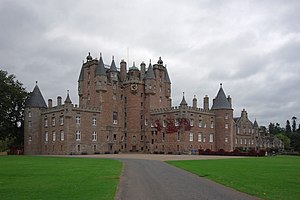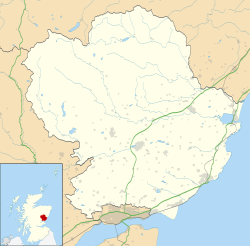Glamis Castle
| Glamis Castle | |
|---|---|
| Near Glamis, Angus, Scotland, United Kingdom | |
 Glamis Castle | |
| Coordinates | 56°37′13″N 3°00′09″W / 56.6203°N 3.0024°W |
| Site information | |
| Open to the public | Yes |
| Condition | Preserved |
| Site history | |
| Materials | Stone |
Glamis Castle is situated beside the village of Glamis (/ˈɡlɑːmz/, glahmz) in Angus, Scotland. It is the home of the Earl of Strathmore and Kinghorne, and is open to the public.
Glamis Castle has been the home of the
The castle is protected as a
Setting
Glamis is set in the broad and fertile lowland valley of
History


The vicinity of Glamis Castle has prehistoric traces; for example, a noted intricately carved Pictish stone known as the Eassie Stone was found in a creek-bed at the nearby village of Eassie.[3]


In 1034 Malcolm II was murdered at Glamis,[4] where there was a Royal Hunting Lodge.[2] In William Shakespeare's play Macbeth (1603–06), the eponymous character resides at Glamis Castle, although the historical King Macbeth (d. 1057) had no connection to the castle.
By 1372 a castle had been built at Glamis, since in that year it was granted by
The title
In 1543, Glamis was returned to
During the Commonwealth of England, Scotland, and Ireland, soldiers were garrisoned at Glamis. In 1670,
In 1900,
Since 1987, an illustration of the castle has featured on the reverse side of ten pound notes issued by the Royal Bank of Scotland.[8] Glamis is currently the home of Simon Bowes-Lyon, 19th Earl of Strathmore and Kinghorne, who succeeded to the earldom in 2016.
Statuary

In the 17th century four "brazen" statues were placed on the approach avenue: Charles I in boots; James VI in a stole; Charles II in Roman dress; and James II as in his Whitehall portrait. The first two were sculpted by Arnold Quellin.[9]
Legends and tales
The Monster of Glamis
The most famous legend connected with the castle is that of the Monster of Glamis, a hideously deformed child born to the family. Some accounts came from singer and composer Virginia Gabriel who stayed at the castle in 1870.[10] In the story, the monster was kept in the castle all his life and his suite of rooms bricked up after his death.[11][12][13][14] Another monster is supposed to have dwelt in Loch Calder near the castle.[citation needed]
An alternative version of the legend is that to every generation of the family a vampire child is born and is walled up in that room.[12]
There is an old story that guests staying at Glamis once hung towels from the windows of every room in a bid to find the bricked-up suite of the monster. When they looked at it from outside, several windows were apparently towel-less. Though this is more likely due to the owners removing them in order so that the guests would not find the rooms, according to several relatives of the family.[12]
The legend of the monster may have been inspired by the true story of the Ogilvies.[12][15][16]
Earl Beardie
A legend tells of the 15th-century "Earl Beardie," who has been identified with both Alexander Lyon, 2nd Lord Glamis (died 1486),
Other traditions
According to the official website for Glamis Castle, in 1034, Malcolm II was mortally wounded in a nearby battle and taken to a Royal Hunting Lodge, which sat at the site of the present castle, where he died.
Description
The towers in front of the castle each measure 7 metres (23 ft) in diameter and are about 4 metres (13 ft) high, each having a modern parapet. The walls are 1 metre (3 ft 3 in) thick.[5]
There is a small chapel within the castle with seating for 46 people. The story given to visitors by castle tour guides states that one seat in the chapel is always reserved for the "White Lady" (supposedly a ghost which inhabits the castle), thought to be
Archives
The clock tower houses the castle's archives which include a wide range of historical material relating to the castle and the Bowes and Lyon families. These include a
In popular culture
In the British children’s television series Thomas & Friends, Lord Callan’s castle is based on Glamis Castle.
The 1982 Yoko Tsuno album La Proie et l'ombre by Roger Leloup prominently features the fictional "Loch Castle", which is drawn as being near-identical to Glamis Castle.
See also
References
- ^ a b c d e f g h Historic Environment Scotland. "Glamis Castle (Category A Listed Building) (LB11701)". Retrieved 1 April 2019.
- ^ a b c d Historic Environment Scotland. "Glamis Castle (GDL00189)". Retrieved 1 April 2019.
- ^ Hogan, C. Michael (7 October 2007). Burnham, Andy (ed.). "Eassie Stone". The Megalithic Portal.
- ^ Black's Picturesque Tourist of Scotland. Adam and Charles Black. 1861.
- ^ a b c "Glamis Castle, Site Number NO34NE 1.00". CANMORE. Royal Commission on the Ancient and Historical Monuments of Scotland. Retrieved 26 August 2011.
- ^ Heritage, Camelot. "Glamis Castle: The Billiard Room". British Heritage and Castles. Camelot Heritage. Retrieved 12 September 2010.
- ISBN 978-1-4050-4859-0
- ^ "Current Banknotes : Royal Bank of Scotland". The Committee of Scottish Clearing Bankers. Retrieved 17 October 2008.
- ^ Scottish Garden Buildings by Tim Buxbaum p.65
- ^ Dash, Mike (10 February 2012), The Monster of Glamis, Smithsonian, retrieved 14 May 2014
- ^ a b c Haunted Castles And Hotels: Glamis Castle Archived 11 September 2019 at the Wayback Machine, Haunted Castles and Hotels, 9 June 2009. Accessed 9 September 2010.
- ^ a b c d Dash, Mike. The Monster of Glamis , CFI Blogs, 9 June 2009. Accessed 8 September 2010.
- ^ The Crawford Papers: The Journals of David Lindsay, Twenty-Seventh Earl of Crawford during the years 1892–1940 (1984) Manchester University Press pp. 86–87
- ^ Wentworth-Day, James (1967). The Queen Mother's Family Story. pp. 133–136.
- ^ T.F. Thistleton Dyer (1900) Strange Pages From Family Papers, pp. 98–103
- ^ Chambers's Journal 1898, pp. 627–28
- ^ Ash, Russell (2009). Top Ten of Britain. Hamlyn Publishing. p. 184.
- ^ Shand, William (24 September 2007). "Earl Beardie - the ghostly Earl of Crawford". Dundee Messenger. Archived from the original on 24 September 2009. Retrieved 19 August 2009.
- ^ "Treasures of Glamis Castle". Archives, Records and Artefacts at the University of Dundee. 15 April 2011. Retrieved 2 February 2012.
External links
- Glamis Castle web site
- Ghosts and Hauntings in Glamis Castle, Mysterious Britain
- The Monster of Glamis Archived 2 February 2013 at archive.today, article by Mike Dash


